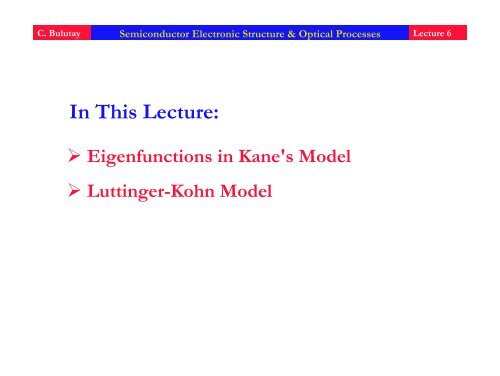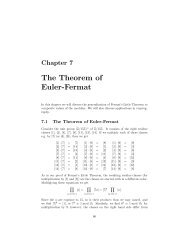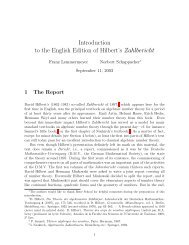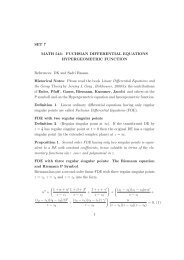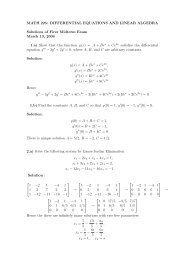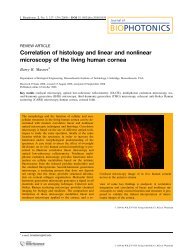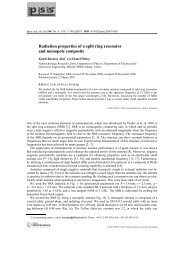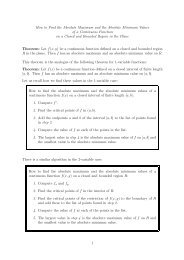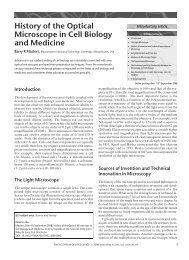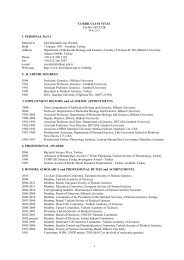In This Lecture:
In This Lecture:
In This Lecture:
Create successful ePaper yourself
Turn your PDF publications into a flip-book with our unique Google optimized e-Paper software.
C. Bulutay Semiconductor Electronic Structure & Optical Processes <strong>Lecture</strong> 6<br />
<strong>In</strong> <strong>This</strong> <strong>Lecture</strong>:<br />
� Eigenfunctions in Kane's Model<br />
� Luttinger-Kohn Model
C. Bulutay Semiconductor Electronic Structure & Optical Processes <strong>Lecture</strong> 6<br />
Kane’s Model: Eigenvectors<br />
where, for upper 4x4 matrix: and from lower 4x4 matrix:<br />
Ref: Chuang
C. Bulutay Semiconductor Electronic Structure & Optical Processes <strong>Lecture</strong> 6<br />
Summary of Kane’s model<br />
with corrected HH<br />
curvature (LK)<br />
Ref: Chuang
C. Bulutay Semiconductor Electronic Structure & Optical Processes <strong>Lecture</strong> 6<br />
The Journey of the Eigenfunctions<br />
For the unperturbed H, eigenfn’s at the band edge we anticipated them to be of s and p<br />
type orbital symmetry: S, ↑ , S, ↓ , X, ↑ , X, ↓ , Y, ↑ , Y, ↓ , Z, ↑ , Z,<br />
↓<br />
u = iS ↓<br />
1<br />
u2<br />
=<br />
X − iY<br />
↑ = Y<br />
2<br />
u = Z ↓ = Y ↓<br />
3<br />
5<br />
7<br />
1 0<br />
1 0<br />
X − iY<br />
u = ↓ = Y<br />
2<br />
1 −1<br />
X + iY<br />
u4<br />
=− ↑ = Y<br />
2<br />
u = iS ↑<br />
u6<br />
X + iY<br />
=− ↓ = Y<br />
2<br />
u = Z ↑ = Y ↑<br />
1 1<br />
1 1<br />
8 1 −1<br />
↑<br />
↓<br />
↑<br />
↓<br />
Perturbation:<br />
SO+k.P<br />
Kane’s band edge eigenfn’s
C. Bulutay Semiconductor Electronic Structure & Optical Processes <strong>Lecture</strong> 6<br />
Refreshment on Addition of Angular Momenta<br />
Spin-orbit coupling: Nonzero angular momentum state e’s (i.e., other than stype<br />
wf’s) generate a magnetic field through which they interact with the spin<br />
of the e. Particulary important for the VB (p-like states).<br />
Because of this coupling neither spin nor orbital angular momentum but the<br />
total angular momentum becomes a good quantum number.<br />
Consider two angular momentum operators which commute with each<br />
other (J 1 , J 2 ), we wish to determine the eigenstates of the total angular<br />
momentum operator J= J 1 +J 2<br />
jm , = ∑ a j, m; j, m<br />
Clebsch-Gordan<br />
coefficients<br />
orbital spin<br />
mm 1 2 1 1 2 2<br />
There are (2J 1 +1) and<br />
(2J 2 +1) states<br />
corresponding to J 1 and J 2
C. Bulutay Semiconductor Electronic Structure & Optical Processes <strong>Lecture</strong> 6<br />
J=L+S<br />
Refreshment on total Angular Momentum (cont’d)<br />
A schematic<br />
representation of<br />
the angular<br />
momentum states<br />
j=l+s=3/2, m j=3/2,…,-3/2<br />
j=l-s=1/2 mj=1/2,-1/2 ls<br />
,<br />
,<br />
Clebsch-Gordan coefficients<br />
for J 1 =1 and J 2 =1/2<br />
Be ware, different<br />
phase choices exist<br />
as in LK<br />
jm<br />
Ref: Singh
C. Bulutay Semiconductor Electronic Structure & Optical Processes <strong>Lecture</strong> 6<br />
Extraction of Kane’s parameter from<br />
experimental data<br />
So, by feeding three parameters from experiment, Kane’s<br />
parameter can be extracted. <strong>This</strong> parameter, P plays a key role in<br />
any optical property regarding the over-the-band gap excitations<br />
Ref: Chuang
C. Bulutay Semiconductor Electronic Structure & Optical Processes <strong>Lecture</strong> 6<br />
General k direction<br />
Up to now, we have assumed:<br />
For a general case:<br />
The following transformations can be used to find the basis<br />
functions in the general coordinate system:<br />
Ref: Chuang
C. Bulutay Semiconductor Electronic Structure & Optical Processes <strong>Lecture</strong> 6<br />
k·p and Similar Band Edge Techniques<br />
Brief Highlights<br />
�Single- and two-band k·p<br />
Coupling to other bands accounted perturbatively<br />
Predicts an analytical effective mass tensor (heavier/lighter than m0 )<br />
�Kane’s Hamiltonian<br />
8 bands (CB+3 VB with spin) treated exactly<br />
Coupling with the other bands neglected<br />
HH band comes out with wrong sign and value (due above approximation)<br />
No warping predicted (i.e., isotropic) for finite k<br />
�Luttinger-Kohn Hamiltonian (for degenerate bands with spin-orbit)<br />
6 VBs treated exactly; can be extended to include CBs as well<br />
Other bands are included via Löwdin’s technique<br />
Warping of the VBs is predicted<br />
�Pikus-Bir Hamiltonian<br />
Just like LK Hamiltonian, but includes the effects of strain in the xtal
C. Bulutay Semiconductor Electronic Structure & Optical Processes <strong>Lecture</strong> 6<br />
Luttinger-Kohn Hamiltonian<br />
Begin with the total<br />
Hamiltonian for the<br />
cell-periodic fn’s<br />
dropping their band<br />
indices for<br />
convenience:<br />
Neglect<br />
compared to<br />
Ref: Chuang
C. Bulutay Semiconductor Electronic Structure & Optical Processes <strong>Lecture</strong> 6<br />
Expand any cell-periodic wfn in terms of the k=0 basis:<br />
where, from Kane’s model we learned that k=0 solutions are of the form:<br />
Ref: Chuang
C. Bulutay Semiconductor Electronic Structure & Optical Processes <strong>Lecture</strong> 6<br />
Also recall that at k=0, band edge fn’s satisy:<br />
where<br />
Now, apply Löwdin’s method:<br />
Effect of remote<br />
bands are here<br />
Ref: Chuang
C. Bulutay Semiconductor Electronic Structure & Optical Processes <strong>Lecture</strong> 6<br />
where<br />
p<br />
Change of notation; let<br />
Ref: Chuang
C. Bulutay Semiconductor Electronic Structure & Optical Processes <strong>Lecture</strong> 6<br />
where<br />
For j=j’, similar to single-band effective mass tensor<br />
To write the matrix elements<br />
explicity, define:<br />
Luttinger parameters<br />
Ref: Chuang
C. Bulutay Semiconductor Electronic Structure & Optical Processes <strong>Lecture</strong> 6<br />
<strong>In</strong> terms of Luttinger parameters, the LK Hamiltonian becomes:<br />
complex conjugate<br />
where<br />
HH<br />
LH<br />
LH<br />
HH<br />
SO<br />
SO<br />
Ref: Chuang
C. Bulutay Semiconductor Electronic Structure & Optical Processes <strong>Lecture</strong> 6<br />
So, essentially we have solved the Hamiltonian<br />
where<br />
For the expansion eigenvectors and eigenvalues:<br />
Ref: Chuang


